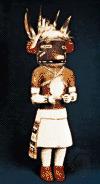- kachina
-
/keuh chee"neuh/, n.1. any of various ancestral spirits deified by the Hopi Indians and impersonated in religious rituals by masked dancers.2. a Hopi religious ritual at which such masked dancers perform.3. a masked dancer impersonating such a spirit at a Hopi religious ritual.[1885-90; < Hopi kacína < Keresan (Santa Ana) k'â·cina (or a cognate word)]
* * *
There are more than 500 of these spirits, who act as intermediaries between humans and the gods. Each tribe has its own kachinas, which are believed to reside with a tribe for half of each year. They can be seen by the community if men properly perform a ritual while wearing kachina masks. The spirit depicted on the mask is thought to be actually present with the performer, temporarily transforming him. Kachinas are also represented by small wooden dolls, carved and decorated by the men of the tribe. Hopi kachina of laqán, or squirrel spirit, c. 1950; in the Museum of the ...By courtesy of the Museum of the American Indian, Heye Foundation, New York City
Hopi kachina of laqán, or squirrel spirit, c. 1950; in the Museum of the ...By courtesy of the Museum of the American Indian, Heye Foundation, New York City* * *
▪ North American Indian religionin traditional religions of the Pueblo Indians of North America, any of more than 500 divine and ancestral spirit beings who interact with humans. Each Pueblo culture has distinct forms and variations of kachinas.Kachinas are believed to reside with the tribe for half of each year. They will allow themselves to be seen by a community if its men properly perform a traditional ritual while wearing kachina masks and other regalia. The spirit-being depicted on the mask is thought to be actually present with or within the performer, temporarily transforming him.Kachinas are also depicted in small, heavily ornamented carved-wood dolls, which are traditionally made by the men of a tribe and presented to girls; boys receive bows and arrows. These wooden dolls are used to teach the identities of the kachinas and the symbolism of their regalia. The identity of the spirit is depicted not by the form of the doll's body, which is usually simple and flat, but primarily by the applied colour and elaborate feather, leather, and, occasionally, fabric ornamentation of its mask.* * *
Universalium. 2010.
